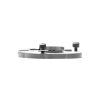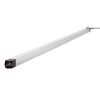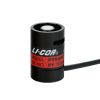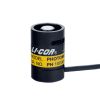LI-COR LI-190R PAR Sensors
Features
- Improved weather resistance and durability in long-term outdoor deployments
- Uniform sensitivity to light that drives photosynthesis
- Removable sensor simplifies installation and removal of the sensor
- Free ground shipping
- Expedited repair and warranty service
- Lifetime technical support
- More
Overview
The LI‑190R uses a high-quality silicon photodiode and glass optical filters to create uniform sensitivity to light between 400 nm to 700 nm, which closely corresponds to light used by most plants. Precision optical filters block light with wavelengths beyond 700 nm, which is critical for measurements under vegetation where the ratio of infrared to visible light may be high.
Applications
Excellent cosine response provides accuracy at low solar angles. This, in combination with high resolution at low light levels, makes the LI-190R useful for determining the light compensation point in plants.
- Absolute Calibration: ± 5% traceable to the U.S. National Institute of Standards and Technology (NIST)
- Sensitivity: Typically 5 μA to 10 μA per 1,000 μmol s-1 m-2
- Linearity: Maximum deviation of 1% up to 10,000 μmol s-1 m-2
- Response Time: Less than 1μs (2 m cable terminated into a 604 Ohm load)
- Temperature Dependence: ± 0.15% per °C maximum
- Cosine Correction: Cosine corrected up to 82° angle of incidence
- Azimuth: < ± 1% error over 360° at a 45° elevation
- Tilt: No error induced from orientation
- Detector: High stability silicon photovoltaic detector (blue enhanced)
- Sensor Housing: Weatherproof anodized aluminum body with acrylic diffuser and stainless steel hardware; O-ring seal on the sensor base
- Size: 2.36 cm diameter × 3.63 cm (0.93” × 1.43”)
- Weight: 24 g head; 60 g base/cable (2 m) with screws
- Cable Length: 2 m, 5 m, 15 m, 50 m (6.5’, 16.4’, 49.2’, 164’)
In The News
University of Minnesota’s Cedar Creek Ecosystem Science Reserve: Making Significant Contributions to Ecosystem Studies and Environmental Monitoring since the 1940s
Cedar Creek Ecosystem Science Reserve is home to several very important research efforts that have made it into the history books. Cedar Creek was once the stomping ground of Raymond Lindeman, also known as “The Grandfather of Ecosystem Ecology.” Cedar Creek was also the first place where automated telemetry of animals’ movements was utilized. It’s also home to the world’s longest biodiversity experiment, the longest-running elevated CO2 experiment, one of the longest fertilization studies and one of the longest-running burn studies to maintain an oak savanna. Cedar Creek is also the global headquarters of the Nutrient Network.
Read MoreWith A Modular Update, LI-COR Terrestrial Light Sensors Shine
For environmental professionals looking to measure light, the sun’s energy or photosynthetically active radiation, there is no better choice than LI-COR’s all-new line of terrestrial light sensors. The series, including the LI-190R, LI-200R and LI-210R, has been redesigned from the ground up and is more convenient, reliable and durable than ever before. The new design centers on a modular setup that lets users detach the sensor head from the base. This makes it possible to swap out sensor heads for calibration or to measure different light parameters. In addition, it adds to project flexibility, saving users time and money.
Read MoreIdaho State Grad Student Lives In Wilderness For Transpiration Study
In order to get the data he needed for his graduate research project, John Whiting had to do a little camping. But this was no weekend research project - he spent more than three months collecting measurements in a wilderness area near Idaho’s Frank Church River. The goal of his research was to measure the impacts that snowpack had on water availability for Douglas Fir trees, the most wide-ranging tree in central Idaho. Data collected would also help answer questions relating to the health of streams and fish in the Pioneer Creek Watershed, as well as ecological effects downstream. He was assisted by Sarah Godsey, a professor of geosciences at Idaho State, and Dylan Refaey, an undergraduate field assistant at the school. Three sites were chosen for the investigation.
Read More

































